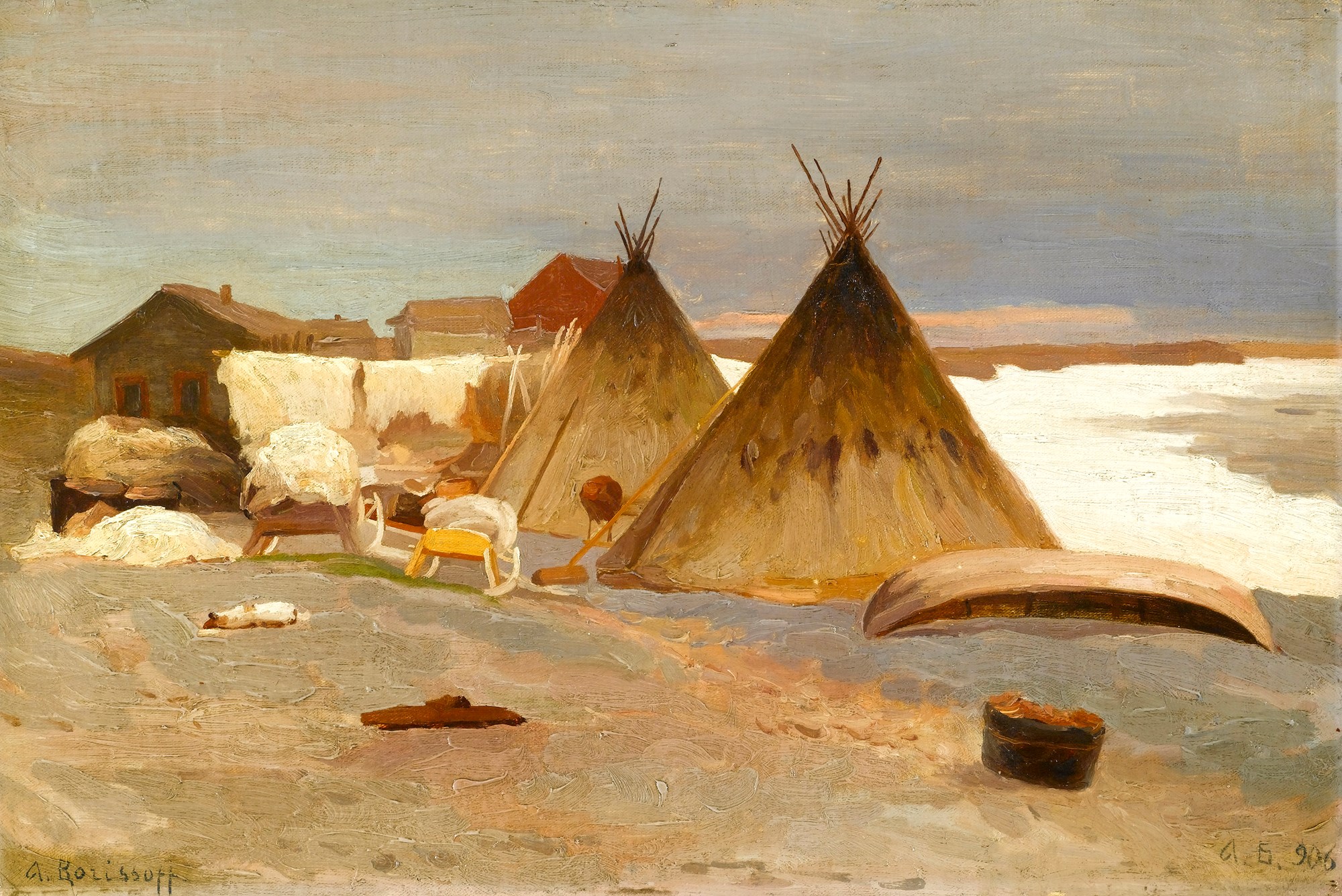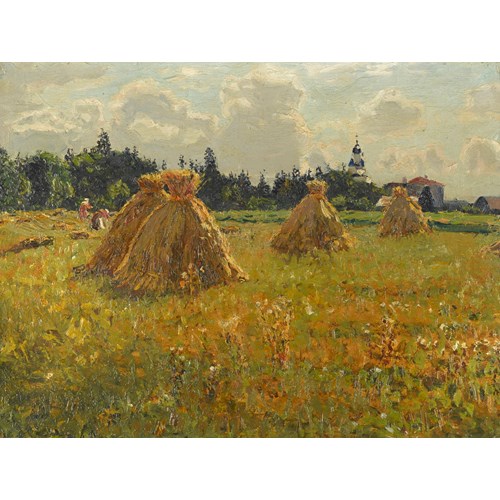Marketplace
Encampment in the Snow
Alexander Alekseevich Borisov
Encampment in the Snow
Date 1906
Period 20th century
Origin Russia
Medium Oil on board
Dimension 35 x 52 cm (13³/₄ x 20¹/₂ inches)
This painting of a traditional choom settlement on the backs of a river was executed during Alexander Alekseevich Borisov’s final expedition to the far north in 1906. The work is both a testimony to the conditions that Borisov had to tolerate during his trips and to his independent style. The board is covered with swirls of paint chosen for their muted tones, and despite the presence of the encampment one gets a sense of the great immensity and loneliness that Borisov must have felt in such surroundings. The ground has thawed somewhat and the villagers have left out an up-turned kayak, a pot, two sleighs and skins drying on a line. There are more permanent dwellings in the background and one wonders if Borisov was one of the last people to witness these people abandoning their nomadic way of life for a less romantic and settled alternative. Despite this poignant subtext of abandonment, the overall effect is one of calm. The influence of Arkhip Ivanovich Kuindzhi (1842-1910), one of Borisov’s tutors whilst at the Imperial Academy of Arts, St. Petersburg, is notable, see for example Moonlight in a Winter Forest. As with Kuindzhi, the paint takes over with vast areas of colour, intensifying the expressive nature of the Russian landscape.
Between 1894 and 1906 Borisov organised several expeditions to the far north for scientific and ethnographical purposes. During this period he painted numerous landscapes and was praised as being one of the first artists to open up the Arctic. There he was amazed by the beauty of the vast landscape with its arctic tundra. Paintings from this period include Afternoon on Novaya Zemlya (1894), The Kara Sea (1896) and and the Tretyakov’s Nenets by a Choom, Malye Karmakuly, Novaya Zemlya,which was painted in the same year and is comparable to the present work. Both works manage to depict the lifestyle of the indigenous people whilst simultaneously conveying the isolation of the vast, untouched landscape. This ability to explore ethnographic themes, within the context of beautifully rendered landscapes is a recurring feature of Borisov’s work. From 1898 he also painted a series of genre scenes featuring the Samoyed people of Siberia. Borisov’s numerous trips to the far north and his interest in its ethnic groups such as the Samoyed people is in keeping with a cultural move to embrace all things Russian; its native people, its true landscape and the rejection of more traditional neo-Classical ideals.
Borisov was born into a peasant family in Vologda Oblast, on 2 November, 1866. He began his artistic career as an icon painter for the Solovetskii monastery, where he ended up working for over forty years. In 1888 he was accepted as a student at the Imperial Academy of Arts where he studied under the guidance of two great Russian painters, Kuindzhi and Ivan Shishkin. Borisov lived in St. Petersburg until 1909 and then moved to the Arkhangelsk Oblast where he died in August 1934. During his lifetime Borisov exhibited at the Imperial Academy of Arts, the Moscow Society of Lovers of Art and also with the Peredvizhinki, (The Wanderers). He held a series of solo exhibitions at St. Petersburg, Vologda, Veliky Ustyug, Moscow and elsewhere abroad. The Borisov Museum in Arkhangelsk is devoted to both his work and his dedication to opening up the Arctic to artistic representation through his tireless expeditions.
Between 1894 and 1906 Borisov organised several expeditions to the far north for scientific and ethnographical purposes. During this period he painted numerous landscapes and was praised as being one of the first artists to open up the Arctic. There he was amazed by the beauty of the vast landscape with its arctic tundra. Paintings from this period include Afternoon on Novaya Zemlya (1894), The Kara Sea (1896) and and the Tretyakov’s Nenets by a Choom, Malye Karmakuly, Novaya Zemlya,which was painted in the same year and is comparable to the present work. Both works manage to depict the lifestyle of the indigenous people whilst simultaneously conveying the isolation of the vast, untouched landscape. This ability to explore ethnographic themes, within the context of beautifully rendered landscapes is a recurring feature of Borisov’s work. From 1898 he also painted a series of genre scenes featuring the Samoyed people of Siberia. Borisov’s numerous trips to the far north and his interest in its ethnic groups such as the Samoyed people is in keeping with a cultural move to embrace all things Russian; its native people, its true landscape and the rejection of more traditional neo-Classical ideals.
Borisov was born into a peasant family in Vologda Oblast, on 2 November, 1866. He began his artistic career as an icon painter for the Solovetskii monastery, where he ended up working for over forty years. In 1888 he was accepted as a student at the Imperial Academy of Arts where he studied under the guidance of two great Russian painters, Kuindzhi and Ivan Shishkin. Borisov lived in St. Petersburg until 1909 and then moved to the Arkhangelsk Oblast where he died in August 1934. During his lifetime Borisov exhibited at the Imperial Academy of Arts, the Moscow Society of Lovers of Art and also with the Peredvizhinki, (The Wanderers). He held a series of solo exhibitions at St. Petersburg, Vologda, Veliky Ustyug, Moscow and elsewhere abroad. The Borisov Museum in Arkhangelsk is devoted to both his work and his dedication to opening up the Arctic to artistic representation through his tireless expeditions.
Date: 1906
Period: 20th century
Origin: Russia
Medium: Oil on board
Signature: Signed ‘A. Borissoff' (lower left), also signed with initials and dated ‘906’ (lower right).
Dimension: 35 x 52 cm (13³/₄ x 20¹/₂ inches)
More artworks from the Gallery




_T638989902574827885.jpg?width=500&height=500&mode=pad&scale=both&qlt=90&format=jpg)




